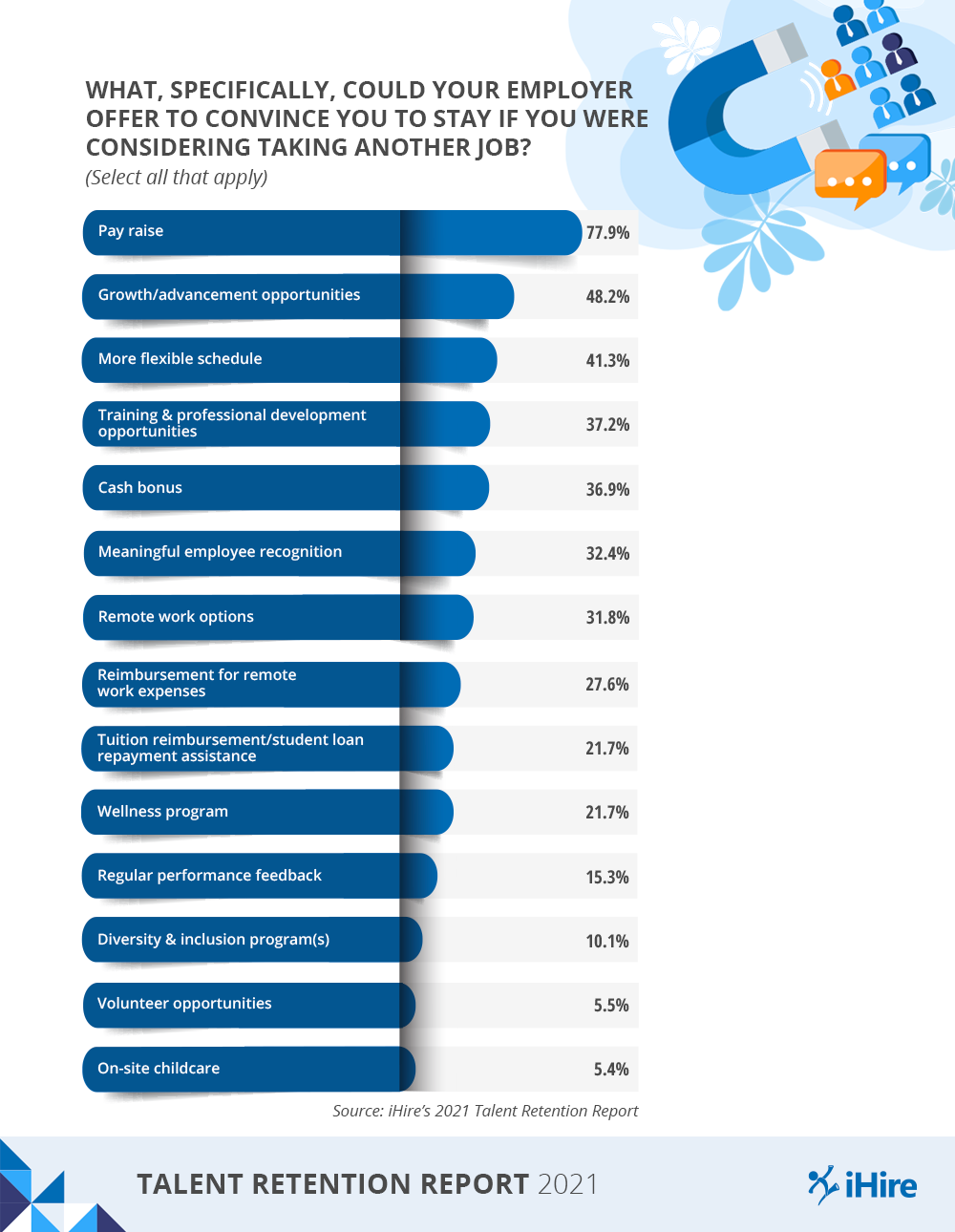- Employer Resources
- |
- Last Updated: November 08, 2021

Resignation-Proofing Your Small Business: 6 Employee Retention Strategies
With record numbers of employees leaving their jobs voluntarily, employee turnover is one of the top HR issues for small businesses. Therefore, an employee retention strategy is crucial to navigating the hiring landscape without potentially losing valued employees.
For iHire’s 2021 Talent Retention Report, we asked 3,948 employees to share their thoughts on why they quit their jobs. The responses in the report provide helpful insight into what employees want – and what you can do to meet their needs – to “resignation-proof” your small business.
What Do Employees Want?
To understand how to keep your employees from leaving, you first need to know what they’re looking for when deciding whether to stay with an employer. To find this answer, iHire’s 2021 Talent Retention Report survey asked workers, “What, specifically, could your employer offer to convince you to stay if you were considering taking another job?”
It’s perhaps expected that 77.9% of respondents said a pay raise would persuade them to stay at their current job (meanwhile, unsatisfactory pay was the No. 1 reason they would depart). Check out the following graph to see how survey participants’ responses stacked up:

How to Keep Employees from Leaving
The survey results above give an inside look at what encourages today’s employees to stick around. Based on those responses, these six employee retention strategies will ensure your workforce remains strong during the “Great Resignation.”
1. Increase Pay or Implement a Bonus
It’s the top reason employees change jobs and the No. 1 incentive for them to remain at a job: a pay bump. To keep your best employees from jumping ship, make sure you’re paying a fair salary based on market standards. Consider this: More than 10 million job openings are available in the U.S., meaning it’s easier than ever for workers to find a position with higher pay. To truly resignation-proof your business, you’ll have to match or exceed the rest of the market. The cost of living has also increased by 5.9%, so paying your employees enough to keep up is critical.
However, not every small business has the budget to raise employees’ salaries. If that’s the case, a one-time end-of-year or merit-based bonus are excellent options. In fact, 36.9% of respondents said a cash bonus would win them over.
2. Offer Advancement and Growth Opportunities
Next to a pay raise, survey respondents desired growth/advancement opportunities as incentives for remaining at a job (48.2%). For example, offer top talent a promotion or a move to a position that expands their skills (a promotion usually involves a pay raise, so budget accordingly). It’s also important that you don’t provide an upgrade in title only – employees will see through that, and it may encourage them to take another job offer instead.
Even if you can’t promote someone right away, map out a plan for helping them take their career to the next level at your organization. What do they need to get there, and what’s in it for them? If they know you’re planning for their future, they’ll be less likely to resign and abandon the progress they’ve made with you.
3. Allow Flexible Scheduling Options
Post-pandemic, many employees hesitate to return to a “9 to 5” job in the office – 41.3% said a more flexible schedule would keep them at their current job, while 31.8% say they’d stay if given remote work options. If the position can accommodate it, allowing staff to work from home or enabling a hybrid office model are effective strategies for lowering employee turnover rates.
Many people are accustomed to working remotely now, and in some roles, there’s nothing they can’t do from home that necessitates an office setting. Therefore, the flexibility of working from home is an enjoyable perk for a lot of employees. In addition, emphasizing a work/home life balance and focusing on results, not time worked, will boost employee satisfaction and reduce stress.

4. Provide Professional Development Assistance
Similar to advancement and growth opportunities, training and professional development options are attractive incentives for employees – 37.2% of respondents said they would remain if presented with prospects for training or development. It’s easy to see why: Your employees have their own career aspirations aside from your company’s goals. If you help them achieve those objectives, they’re more likely to enjoy working with you and see your company as an asset to their career. Facilitate professional development with personalized coaching sessions, online courses, and on-the-job training.
Tuition reimbursement is a popular incentive as well – 21.7% of survey participants said they wouldn’t quit if their employer offered to cover the costs of their education. Usually, tuition reimbursement covers courses taken while working at the company. However, some programs stipulate that the employee must continue working there for a certain amount of time after completing the courses or pay back the costs, delaying resignation.
5. Recognize Employee Performance and Give Feedback
It’s always nice to be recognized for a job well done, and it‘s no surprise that acknowledging your team’s efforts can reduce employee turnover. Meaningful employee recognition ranked sixth on the list of employee “wants,” with 32.4% of survey respondents saying it would convince them to stay. Along with that metric, 15.3% of workers said they’d remain at their job if given regular performance feedback.
There are many ways to recognize outstanding employees, from a “wall of fame” to extra days off or a bonus, but your efforts must be meaningful. Letting your employees know that their work is valued will increase their job satisfaction, leading to a lower turnover rate.
Create Your Account Today
6. Enhance Your Benefits Package
Finally, look at your benefits package and determine what you can add or improve. Many of the survey responses fall under the benefits category, including reimbursing staff for remote work expenses (27.6%), implementing a wellness program (21.7%), including a diversity & inclusion program (10.1%), organizing volunteer opportunities (5.5%), and setting up on-site childcare (5.4%). Employee benefits are often overlooked for other aspects of a job, like salary. But, if you have a compelling total compensation package that can’t be found elsewhere, it may be enough to sway an employee who’s on the fence.
Creating and implementing a solid small business employee retention strategy is key to combatting the Great Resignation. If you follow the tips above, your business will be resignation-proof for the coming months. Download iHire’s full Talent Retention Report for more insights into how you can reduce employee turnover and keep your top workers aboard.

November 03, 2021




